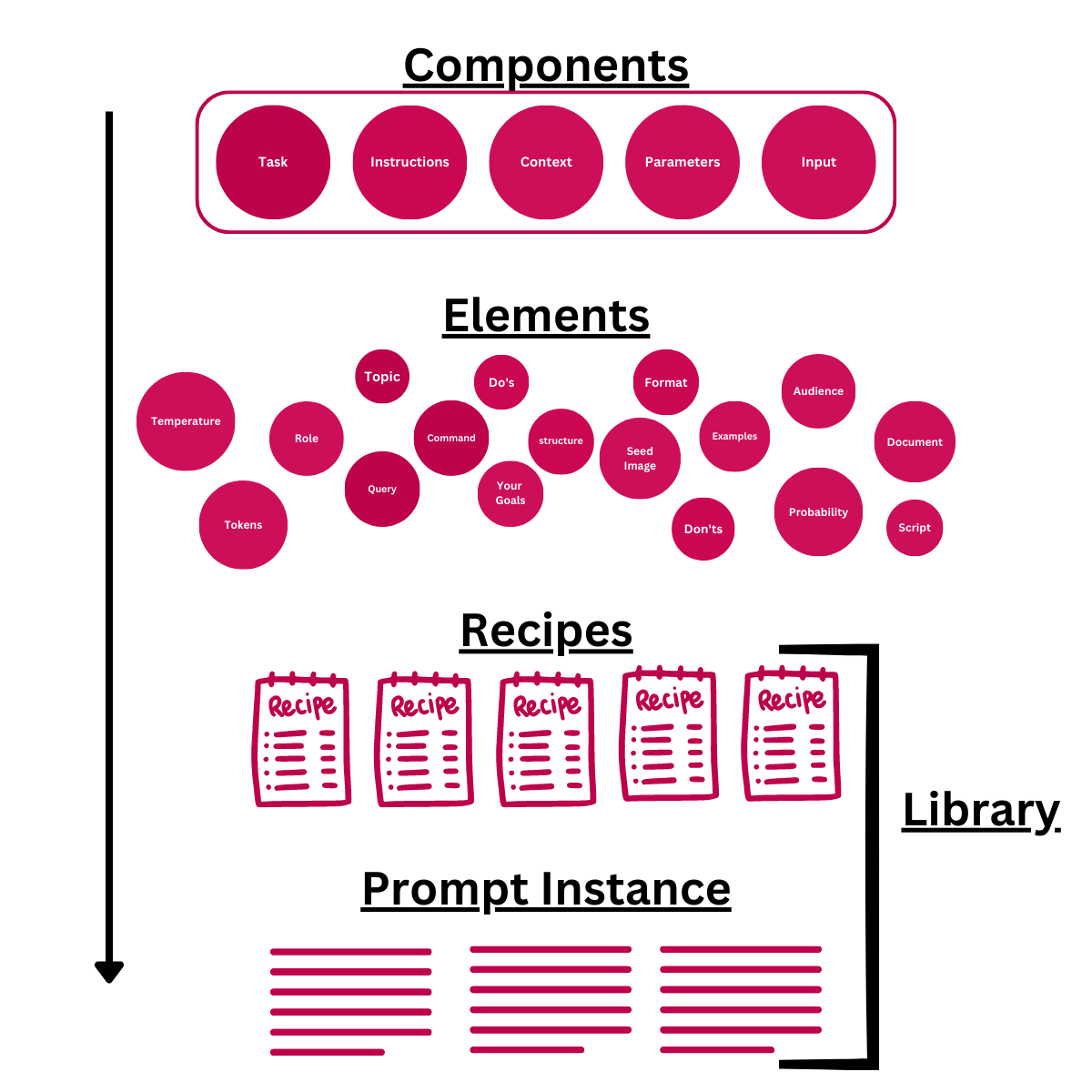Prompt libraries play a crucial role in enhancing the efficiency and organization of AI prompts in prompt engineering activities by providing a centralized platform for easy retrieval, recording, and utilization of prompt recipes and prompts.
Introduction to Prompt Libraries
Prompt libraries have emerged as essential tools in the field of AI prompt engineering. By offering a centralized database or repository for organizing and storing prompt recipes and prompts, these libraries streamline the process of prompt engineering, leading to improved efficiency and effectiveness. In this lesson, we will explore the significance of prompt libraries, discuss the benefits of using tools like Excel for organizing prompts, and demonstrate how a well-structured prompt library can contribute to the overall success of AI-driven projects.
Why Maintain a Prompt Library: The Value for Professionals and Everyday Users
Maintaining a prompt library is essential for both professional prompt engineers and everyday users who rely on AI systems. By investing time and effort into creating and updating a prompt library, users can experience numerous benefits that improve the overall AI experience.
Greater Efficiency and Speed in Prompt Engineering
By maintaining a prompt library, users can save time and resources when implementing AI solutions. With a curated set of tested and optimized prompts at their disposal, users can quickly identify the most suitable prompts for their projects, avoiding the need to create new prompts from scratch. This not only saves time but also ensures that AI-generated outputs are more reliable and accurate.
Creating prompts from scratch can be time-consuming, especially when developing prompts for multiple AI models and use cases. By utilizing a well-maintained prompt library, prompt engineers can save time and effort by leveraging pre-existing prompts that have already been tested and optimized. This allows for a more streamlined approach to testing and evaluation, as the performance of these prompts has already been measured. Additionally, an organized prompt library can significantly reduce the time it takes to find or modify suitable prompts for specific projects.
Organization and Centralization of Prompts
A primary advantage of prompt libraries is their ability to organize and centralize all prompt-related information. By consolidating prompt recipes and scripts into one location, prompt libraries make it easier for engineers and researchers to access and utilize the information needed for their work. This centralization eliminates the need to search through disparate sources and reduces the risk of losing or misplacing valuable data. This increased organization leads to more efficient and effective prompt engineering processes.
Improved AI Performance and Reliability
A well-maintained prompt library can contribute to better AI performance by offering prompts that have been fine-tuned for specific use cases and applications. These optimized prompts lead to more accurate and relevant outputs, reducing the likelihood of errors and inconsistencies. By using prompts from a maintained library, users can trust that their AI systems are working optimally and delivering reliable results.
Facilitated Collaboration and Knowledge Sharing
Prompt libraries not only serve as a valuable resource for individual prompt engineers but also foster collaboration and knowledge sharing among professionals in the field. By sharing prompts and strategies for prompt development and optimization, prompt engineers can learn from one another and improve their collective knowledge and skills. This collaborative environment leads to more efficient problem-solving and fosters a sense of community among professionals.
Scalability and Customization
As AI models evolve and new use cases emerge, prompt libraries can be easily updated and expanded to accommodate these changes. This allows prompt engineers to stay current with the latest developments in AI and ensure that their libraries remain relevant and useful. Moreover, prompt libraries can be customized to fit specific needs, enabling prompt engineers to create tailored solutions for their clients or organizations.
Enhanced User Experience
A maintained prompt library can lead to a better user experience for those interacting with AI-driven applications. By using optimized prompts, AI systems can provide more consistent and accurate outputs, increasing user trust and satisfaction. This, in turn, contributes to the overall success and adoption of AI applications across various industries.
Increased Accuracy and Effectiveness of AI Systems
A well-structured prompt library contains prompts that have been optimized for specific use cases, ensuring that the output produced by the AI system is tailored to the intended application. This reduces the risk of errors and increases the reliability of the system. By using a prompt library, prompt engineers can more easily find the most suitable prompts for their projects, leading to more accurate results and better overall performance.
Tackling Flexibility Challenges in Prompt Engineering with a Prompt Library
The inherent flexibility of natural languages presents unique challenges in prompt engineering. This flexibility comes from both user-defined instructions and AI-generated responses, leading to silent failures, ambiguous output formats, and inconsistencies in user experience. A well-structured prompt library can address these challenges and provide a more reliable developer experience.
Minimizing Silent Failures
A comprehensive prompt library helps reduce the risk of silent failures by offering tested and optimized prompts that have already proven to generate consistent and accurate results. By leveraging these pre-existing prompts, developers can minimize the possibility of errors resulting from accidental changes or poorly-crafted prompts. Moreover, a well-maintained prompt library can provide guidelines and best practices for prompt creation, further reducing the likelihood of silent failures.
Reducing Ambiguity in Output Format
A prompt library can also provide developers with a collection of prompts that have been optimized to generate outputs in specific formats, ensuring consistency and compatibility with downstream applications. By using these prompts, developers can ensure that AI-generated responses are more likely to adhere to the desired format, reducing the risk of ambiguous or incompatible outputs. Additionally, prompt libraries can include tips and techniques for crafting prompts that explicitly specify the desired output format, increasing the reliability of the AI system.
Enhancing Consistency in User Experience
Finally, a prompt library can address the challenge of inconsistency in user experience by offering prompts that have been fine-tuned to produce consistent results across multiple runs. By setting the appropriate parameters (e.g., temperature = 0) and using well-optimized prompts from the library, developers can ensure that AI-generated responses are more consistent and trustworthy. Furthermore, a prompt library can offer insights and recommendations on how to manage the inherently stochastic nature of AI models to provide a more dependable user experience.
A well-maintained prompt library should include strategies for prompt versioning and optimization to ensure the highest level of performance and reliability.
Creating a Prompt Library
Creating a prompt library involves organizing an assortment of prompt recipes and prompts, along with other related elements, to facilitate the efficient development and testing of prompt recipes for specific purposes. In this section, we will outline the steps and considerations for creating your own prompt library.

Excel as a Tool for Managing Prompt Libraries (My Choice).
One example of a tool that can be used to create and manage prompt libraries is Microsoft Excel.
As a versatile and widely-used spreadsheet program, Excel offers numerous features that can facilitate the organization of prompt recipes and scripts. By creating a dedicated workbook for a prompt library, users can easily input, sort, and filter prompt data, enabling quick and straightforward access to the information they need. Additionally, Excel supports various data visualization tools, such as charts and graphs, to help users better understand and analyze their prompt data.
1. Determine the Library's Purpose and Scope
Before building your prompt library, it is essential to identify its purpose and scope. Consider the types of projects, industries, or use cases you want the library to support. This will help guide the organization and selection of prompts, as well as inform the creation of any additional building blocks or data definitions.
2. Compile Prompt Recipes and Prompts
Gather prompt recipes and prompts relevant to your library's purpose and scope. These can be collected from various sources, such as existing projects, online resources, or even created from scratch. Ensure that the prompts are optimized for their intended AI models and use cases.
3. Include Building Blocks and Data Definitions (Optional)
To streamline the development of prompt recipes, include predefined prompt elements such as roles, output formats, and other building blocks. Additionally, incorporate data definitions that provide context or supplementary information for prompt creation and testing. These elements will assist in the fast development of prompt recipes by offering reusable components.
4. Organize Prompts and Related Elements
Once you have compiled the necessary components, organize them using one or multiple methods outlined in Section VI, such as by category, use case, or performance metrics. This organization will make it easier for users to locate relevant prompts and building blocks, enhancing the overall efficiency of the library.
5. Establish a System for Updating and Maintaining the Library
To ensure your prompt library remains relevant and useful over time, establish a system for updating and maintaining its contents. This can include adding new prompts, updating existing ones, or even removing outdated or underperforming prompts. Additionally, consider incorporating a method for tracking prompt performance and usage, as this data can inform future updates and improvements to the library.
6. Provide Documentation and Support
Lastly, create documentation and resources to support users in navigating and utilizing your prompt library. This can include guidelines for using the library, examples of prompt recipes, and best practices for prompt creation and testing. Providing this support will further enhance the efficiency and effectiveness of your prompt library, ensuring that users can quickly and confidently develop AI-driven solutions tailored to their specific needs.
Note on Methods for Organizing Prompts in a Library
There are several ways to arrange prompts in a library, depending on your specific needs and preferences. Here are a few common methods:
By Category or Domain: You can group prompts by their main category or domain, such as finance, healthcare, education, or customer service. This arrangement makes it easy to locate prompts relevant to a particular industry or field.
By Sub-Category: Within each category or domain, you can further organize prompts by sub-categories, providing more granular classification. For example, within the healthcare domain, you could have sub-categories like diagnostics, treatment, patient care, or insurance.
By Use Case or Application: Organizing prompts by their specific use cases or applications can help users quickly find prompts that align with their project's requirements. Examples of use cases might include sentiment analysis, summarization, translation, or question-answering.
By AI Model Version: If your prompt library supports multiple AI models or model versions, you can arrange prompts based on the model version they are optimized for. This ensures that users can easily find prompts that work best with their chosen AI model.
By Performance Metrics: You can also arrange prompts based on their performance metrics, such as accuracy, user satisfaction, or response time. This organization method can help users prioritize prompts that meet their desired performance criteria.
By Date Created or Modified: Organizing prompts by their creation or modification date can help users track the evolution of the library and easily identify the most recent or updated prompts.
Alphabetically: Another straightforward method is to arrange prompts alphabetically by their prompt text or prompt ID. This approach can be useful if users are familiar with the prompts or are looking for a specific prompt.
Custom Tags or Labels: You can create custom tags or labels to categorize prompts based on specific criteria or characteristics that are important to your organization. Examples of custom tags might include the level of difficulty, language, or prompt author.
By Project: Organize prompts according to specific projects or initiatives within your organization. This arrangement can help users quickly locate prompts relevant to their current project, streamlining the AI integration process.
By Website: If your organization manages multiple websites or web pages, you can group prompts by the website they are used on or designed for. This organization method makes it easier to find prompts tailored for a particular website's content or audience.
By Campaign: Arrange prompts based on marketing or advertising campaigns they are part of or support. This approach helps users working on campaign-related tasks to easily access and select the appropriate prompts for their specific campaign objectives.
By Persona: Organize prompts according to user personas or target audience segments. This arrangement allows users to quickly identify prompts that cater to specific user groups, ensuring a personalized and relevant AI-driven experience for the target audience.
Take Away
Prompt libraries play a vital role in the field of AI prompt engineering by offering a centralized and organized platform for managing and utilizing prompt recipes and scripts. By exploring the various methods for organizing prompts, understanding the key components of a prompt library, and learning how to create your own, you can effectively streamline the development and testing of AI-driven solutions tailored to specific needs and use cases.
Prompt libraries not only improve efficiency but also foster collaboration and innovation, ultimately contributing to the success of AI-driven projects and the advancement of the field as a whole. As AI technology continues to evolve, prompt libraries will remain an invaluable tool for researchers, engineers, and developers working on diverse projects and applications.
In the next article, we will delve deeper into the practical applications of prompt libraries by walking through two examples: one tailored for professional everyday use cases and another designed specifically for app development. By examining these examples, you will gain further insight into the versatility and benefits of prompt libraries, empowering you to leverage this powerful tool to enhance your AI-driven projects and solutions.








